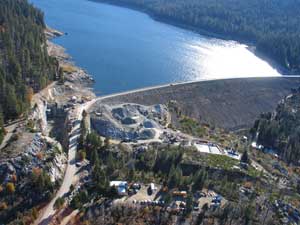The spillway modification at the 231-foot-high L.L. Anderson Dam near Sacramento, CA , which was modified to accommodate higher probable maximum flood levels (PMF) than deemed necessary during initial operation, has been honored by two industry organizations for technical excellence and commitment to safety. The project was awarded the 2011 Heavy Civil Construction Project of the Year award from the Sacramento chapter of the American Society of Civil Engineers (ASCE) and most recently, the 2012 Project of the Year award in the $10 million to $50 million small agency division, in the structures category, by the Sacramento Chapter of the American Public Works Association.
The multi-purpose water supply and hydroelectric dam, originally constructed in 1966, diverts water from the Middle Fork American River watershed to the  Rubicon River watershed to support power generation at a series of hydroelectric powerhouses, including the French Meadows Powerhouse. The LL Anderson dam spillway, located on the north (right) abutment of the dam, originally included a 48-foot-wide approach channel excavated in rock leading to a gated concrete ogee weir equipped with two 20-foot-wide by 18.5-foot-high radial gates.
Rubicon River watershed to support power generation at a series of hydroelectric powerhouses, including the French Meadows Powerhouse. The LL Anderson dam spillway, located on the north (right) abutment of the dam, originally included a 48-foot-wide approach channel excavated in rock leading to a gated concrete ogee weir equipped with two 20-foot-wide by 18.5-foot-high radial gates.
Since the dam’s completion, the PMF calculation has been updated several times from the original estimate of 29,300 cfs to a study in 2005 identifying the PNF inflow estimate of 59,100 cfs. Hydraulic routing of the latest PMF indicated that the spillway did not have enough capacity and the dam would be overtopped by flood, putting the dam at high risk of failure under extreme flood conditions. In addition to posing great risk to people and property downstream, an assumed failure of L.L. Anderson would also exacerbate the current need to upgrade spillway capacity downstream at Folsom Dam, substantially increasing project costs. Due to these risks, the project regulatory agency, the Federal Energy Regulatory Commission (FERC), mandated that Placer County Water Agency (PCWA) address the spillway capacity at L.L. Anderson.
MWH began the design phase of the project with development of spillway modification concepts that were initially performed using industry standard equations and software packages, and verification of feasible concepts by a 1:20 scale physical model. Based on results from the physical model studies, the project design required modification of the existing spillway only in its upper channel, upstream of the first 40-foot drop. Modifications included 14 to 30-feet of widening along the upper spillway channel, a new gate structure downstream of the existing structure, new gate controls and instrumentation that include provisions for future remote operation, a nominal dam raise, a parapet wall along the 2,700 foot dam crest, and site improvements to limit access and improve public safety. Construction of the L.L. Anderson Dam Spillway Modification Project started in April 2010 and was substantially completed in December 2011.
